Citroen C1 DAG 2008.5 1.G Repair Manual
Manufacturer: CITROEN, Model Year: 2008.5, Model line: C1 DAG, Model: Citroen C1 DAG 2008.5 1.GPages: 99, PDF Size: 4.05 MB
Page 61 of 99

6
56
SAFETY When this warning lamp
comes on, it indicates that
there is a malfunction of the
ABS, which can cause a
loss of control of the vehicle
when braking.
Consult a CITROËN dealer.
When these warn-
ing lamps come
on simultaneous-
ly, it indicates that
there is a malfunc-
tion of the braking system or that the
parking brake has not been released
fully, which can cause a loss of con-
trol of the vehicle when braking.
Stop immediately.
Consult a CITROËN dealer.
Normal operation of the ABS
may make itself felt by slight
vibrations of the brake pedal.
In emergency braking,
�p�r�e�s�s� �v�e�r�y� �fi� �r�m�l�y� �w�i�t�h�o�u�t�
releasing the pressure. TRACTION CONTROL (ASR)
AND DYNAMIC STABILITY
CONTROL (ESP)
These systems are linked and sup-
plement the ABS.
The ASR system optimises drive to
prevent the wheels skidding, by act-
ing on the brakes of the driving wheels
and on the engine. It also allows the
directional stability of the vehicle to
be improved on acceleration.
If there is a variation between the tra-
jectory followed by the vehicle and
that required by the driver, the ESP
system automatically acts on the
brake of one or more wheels and on
the engine to put the vehicle back on
course, within the limits of the laws
of physics.
Operating check
Operation of the ASR and ESP
systems When one of these two
systems is operating, this
warning lamp comes on. When a malfunction of the
systems occurs, this warn-
ing lamp comes on.
The ASR/ESP systems offer
exceptional safety during nor-
mal driving, but this should
not encourage the driver to
take extra risks or drive at
high speed.
Correct operation of these systems
depends on observation of the man-
ufacturer's recommendations re-
garding the wheels (tyres and rims),
the braking components and the
electronic components as well as the
CITROËN dealer repair procedures.
After an impact, have these systems
checked by a CITROËN dealer.
Activation of the ESP system is also
accompanied by an audible signal. Contact a CITROËN dealer to have
the systems checked.
Page 62 of 99
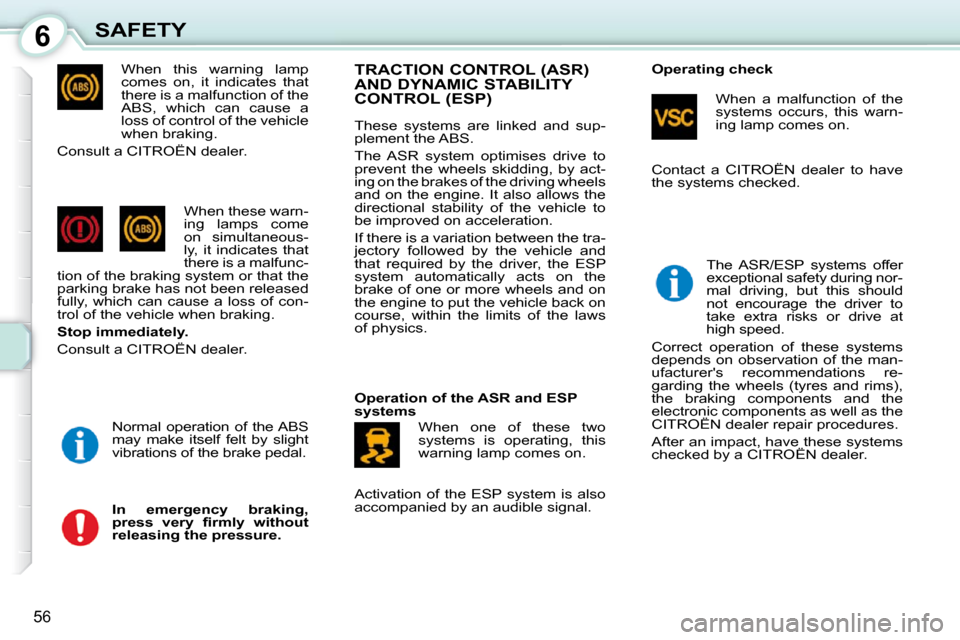
6
56
SAFETY When this warning lamp
comes on, it indicates that
there is a malfunction of the
ABS, which can cause a
loss of control of the vehicle
when braking.
Consult a CITROËN dealer.
When these warn-
ing lamps come
on simultaneous-
ly, it indicates that
there is a malfunc-
tion of the braking system or that the
parking brake has not been released
fully, which can cause a loss of con-
trol of the vehicle when braking.
Stop immediately.
Consult a CITROËN dealer.
Normal operation of the ABS
may make itself felt by slight
vibrations of the brake pedal.
In emergency braking,
�p�r�e�s�s� �v�e�r�y� �fi� �r�m�l�y� �w�i�t�h�o�u�t�
releasing the pressure. TRACTION CONTROL (ASR)
AND DYNAMIC STABILITY
CONTROL (ESP)
These systems are linked and sup-
plement the ABS.
The ASR system optimises drive to
prevent the wheels skidding, by act-
ing on the brakes of the driving wheels
and on the engine. It also allows the
directional stability of the vehicle to
be improved on acceleration.
If there is a variation between the tra-
jectory followed by the vehicle and
that required by the driver, the ESP
system automatically acts on the
brake of one or more wheels and on
the engine to put the vehicle back on
course, within the limits of the laws
of physics.
Operating check
Operation of the ASR and ESP
systems When one of these two
systems is operating, this
warning lamp comes on. When a malfunction of the
systems occurs, this warn-
ing lamp comes on.
The ASR/ESP systems offer
exceptional safety during nor-
mal driving, but this should
not encourage the driver to
take extra risks or drive at
high speed.
Correct operation of these systems
depends on observation of the man-
ufacturer's recommendations re-
garding the wheels (tyres and rims),
the braking components and the
electronic components as well as the
CITROËN dealer repair procedures.
After an impact, have these systems
checked by a CITROËN dealer.
Activation of the ESP system is also
accompanied by an audible signal. Contact a CITROËN dealer to have
the systems checked.
Page 63 of 99
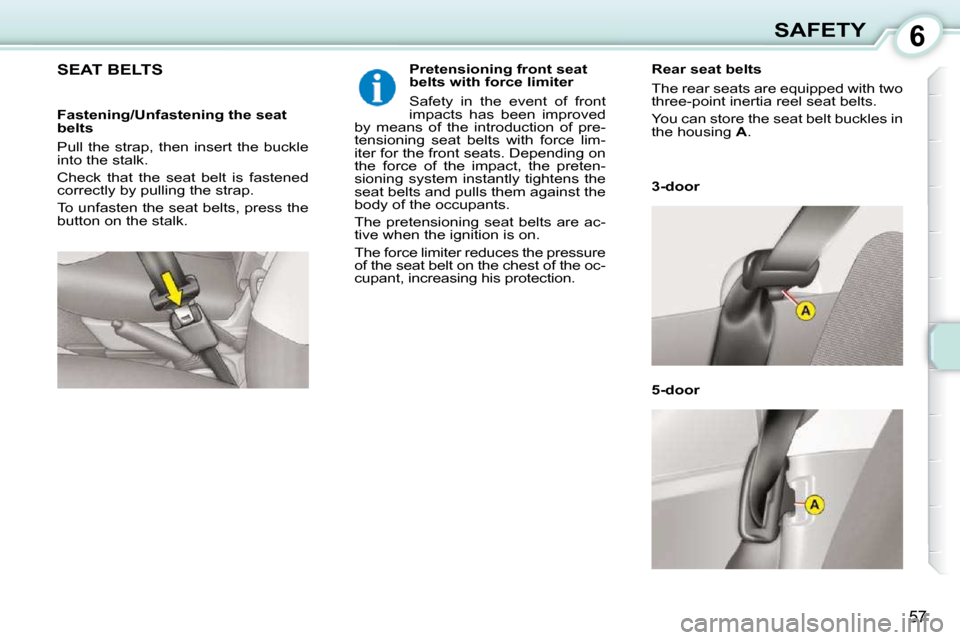
6
57
SAFETY
SEAT BELTS Pretensioning front seat
belts with force limiter
Safety in the event of front
impacts has been improved
by means of the introduction of pre-
tensioning seat belts with force lim-
iter for the front seats. Depending on
the force of the impact, the preten-
sioning system instantly tightens the
seat belts and pulls them against the
body of the occupants.
The pretensioning seat belts are ac-
tive when the ignition is on.
The force limiter reduces the pressure
of the seat belt on the chest of the oc-
cupant, increasing his protection. 3-door
5-door
Rear seat belts
The rear seats are equipped with two
three-point inertia reel seat belts.
You can store the seat belt buckles in
the housing
A .
Fastening/Unfastening the seat
belts
Pull the strap, then insert the buckle
into the stalk.
Check that the seat belt is fastened
correctly by pulling the strap.
To unfasten the seat belts, press the
button on the stalk.
Page 64 of 99

6
58
SAFETY The driver must ensure that
the passengers use the seat
belts correctly and that they
are all properly restrained
before setting off.
Wherever you are seated in the ve-
hicle, always fasten your seat belt,
even for short journeys.
Do not invert the seat belt buckles as
�t�h�e�y� �w�i�l�l� �n�o�t� �f�u�l�fi� �l� �t�h�e�i�r� �r�o�l�e� �f�u�l�l�y�.�
If the seats have armrests * , the lap
part of the seat belt must always
pass under the armrest.
� �T�h�e� �s�e�a�t� �b�e�l�t�s� �a�r�e� �fi� �t�t�e�d� �w�i�t�h� �a�n� �i�n�-
ertia reel permitting automatic adjust-
ment of the length of the strap to your
size. The seat belt is stored automat-
ically when not in use.
Before and after use, ensure that the
seat belt is reeled in correctly.
The lower part of the strap must be
positioned as low as possible on the
pelvis.
The upper part must be positioned in
the hollow of the shoulder.
� �T�h�e� �i�n�e�r�t�i�a� �r�e�e�l�s� �a�r�e� �fi� �t�t�e�d� �w�i�t�h� �a�n� �a�u�-
tomatic locking device which comes
into operation in the event of a colli-
sion, on emergency braking or if the
vehicle rolls over. You can release
the device by pulling rapidly on the
strap and releasing it. In order to be effective, a seat belt:
- must be tightened as close to the
body as possible,
- must restrain one adult only,
- must not bear any trace of cuts or fraying,
- must be pulled in front of you with a smooth movement, checking
that it does not twist,
- must not be transformed or modi- �fi� �e�d� �t�o� �a�v�o�i�d� �a�l�t�e�r�i�n�g� �i�t�s� �p�e�r�f�o�r�m�-
ance.
In accordance with current safety
regulations, all repairs and checks
must be carried out by a CITROËN
dealer who guarantees that the work
is carried out correctly.
Have your seat belts checked regu-
larly by a CITROËN dealer and par-
ticularly if the straps show signs of
damage.
Clean the seat belt straps with soapy
water or a textile cleaning product,
sold by CITROËN dealers.
After folding or moving a seat or rear
bench seat, ensure that the seat belt
is positioned and rolled up correctly. Recommendations for children:
- use a suitable child seat if the pas-
senger is less than 12 years old or
�s�h�o�r�t�e�r� �t�h�a�n� �o�n�e� �m�e�t�r�e� �fi� �f�t�y�,�
- do not use the strap-guide * when a child seat is installed.
- never use the same seat belt to secure more than one person,
- never allow a child to travel on your lap.
Depending on the nature and se-
riousness of the impacts , the pre-
tensioning device may be triggered
before and independently of the air
bags. Triggering of the pre-tensioners
is accompanied by a slight emission
of harmless smoke and a noise, due
to the activation of the pyrotechnic
cartridge incorporated in the system.
In all cases, the air bag warning lamp
comes on.
Following an impact, have the seat
belts system checked, and if neces-
sary replaced, by a CITROËN dealer.
* According to model.
Page 65 of 99
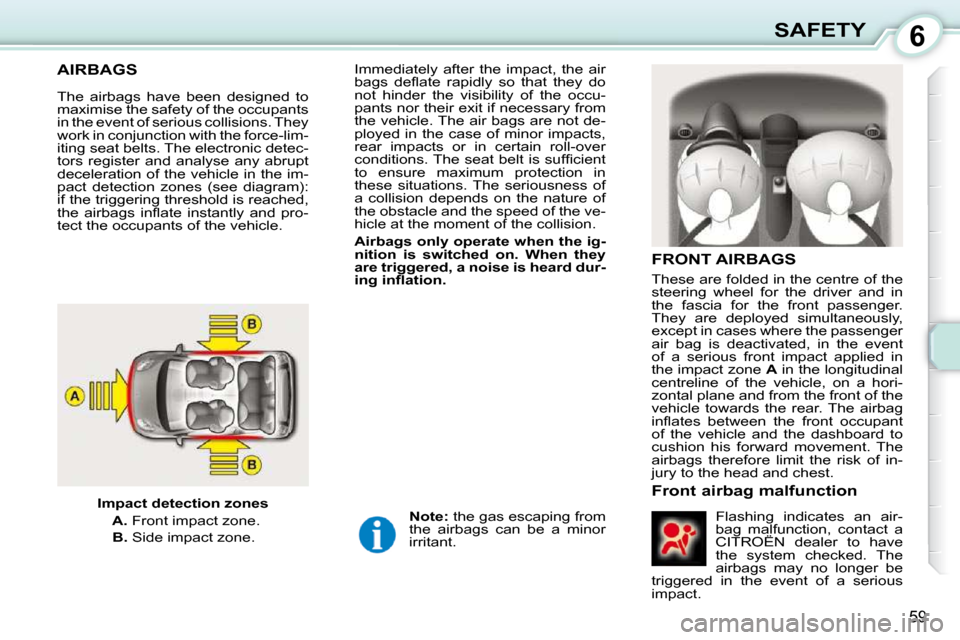
6
59
SAFETY
AIRBAGS
The airbags have been designed to
maximise the safety of the occupants
in the event of serious collisions. They
work in conjunction with the force-lim-
iting seat belts. The electronic detec-
tors register and analyse any abrupt
deceleration of the vehicle in the im-
pact detection zones (see diagram):
if the triggering threshold is reached,
�t�h�e� �a�i�r�b�a�g�s� �i�n�fl� �a�t�e� �i�n�s�t�a�n�t�l�y� �a�n�d� �p�r�o�-
tect the occupants of the vehicle.
FRONT AIRBAGS
These are folded in the centre of the
steering wheel for the driver and in
the fascia for the front passenger.
They are deployed simultaneously,
except in cases where the passenger
air bag is deactivated, in the event
of a serious front impact applied in
the impact zone A in the longitudinal
centreline of the vehicle, on a hori-
zontal plane and from the front of the
vehicle towards the rear. The airbag
�i�n�fl� �a�t�e�s� �b�e�t�w�e�e�n� �t�h�e� �f�r�o�n�t� �o�c�c�u�p�a�n�t�
of the vehicle and the dashboard to
cushion his forward movement. The
airbags therefore limit the risk of in-
jury to the head and chest.
Front airbag malfunction
Flashing indicates an air-
bag malfunction, contact a
CITROËN dealer to have
the system checked. The
airbags may no longer be
triggered in the event of a serious
impact .
Note: the gas escaping from
the airbags can be a minor
irritant.
Immediately after the impact, the air
�b�a�g�s� �d�e�fl� �a�t�e� �r�a�p�i�d�l�y� �s�o� �t�h�a�t� �t�h�e�y� �d�o�
not hinder the visibility of the occu-
pants nor their exit if necessary from
the vehicle. The air bags are not de-
ployed in the case of minor impacts,
rear impacts or in certain roll-over
�c�o�n�d�i�t�i�o�n�s�.� �T�h�e� �s�e�a�t� �b�e�l�t� �i�s� �s�u�f�fi� �c�i�e�n�t�
to ensure maximum protection in
these situations. The seriousness of
a collision depends on the nature of
the obstacle and the speed of the ve-
hicle at the moment of the collision.
Airbags
only operate when the ig-
nition is switched on. When they
are triggered, a noise is heard dur-
�i�n�g� �i�n�fl� �a�t�i�o�n�.�
Impact detection zones
A. Front impact zone.
B. Side impact zone.
Page 66 of 99
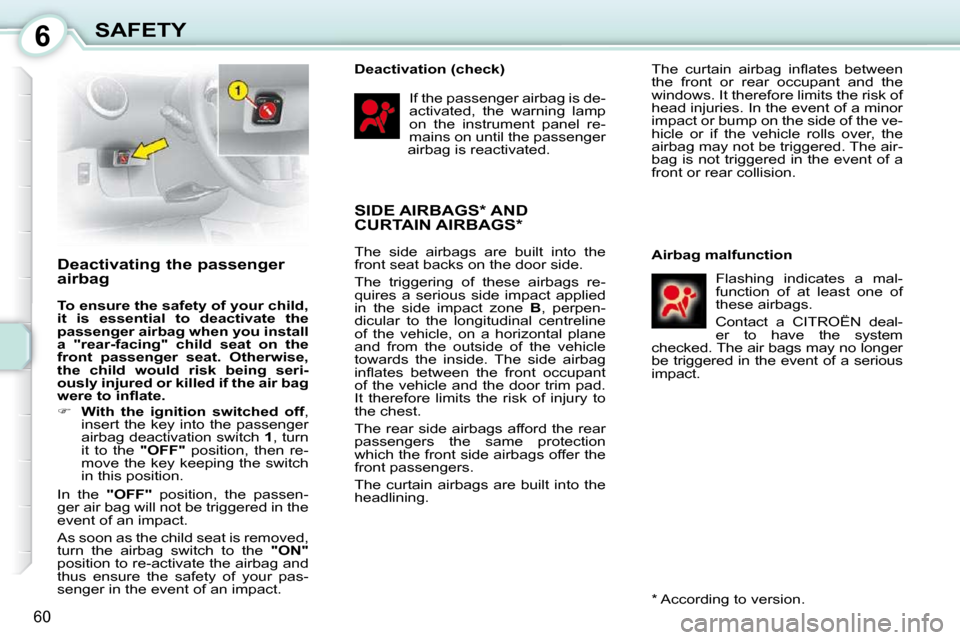
6
60
SAFETY
Deactivating the passenger
airbag
To ensure the safety of your child,
it is essential to
deactivate
the
passenger
airbag
when you install
a "rear-facing" child seat on the
front passenger seat. Otherwise,
the child would risk being seri-
ously injured or killed if the air bag
�w�e�r�e� �t�o� �i�n�fl� �a�t�e�.�
�� With the ignition switched off ,
insert the key into the passenger
airbag deactivation switch 1 , turn
it to the "OFF" position, then re-
move the key keeping the switch
in this position.
In the "OFF" position, the passen-
ger air bag will not be triggered in the
event of an impact.
As soon as the child seat is removed,
turn the airbag switch to the "ON"
position to re-activate the airbag and
thus ensure the safety of your pas-
senger in the event of an impact. If the passenger airbag is de-
activated, the warning lamp
on the instrument panel re-
mains on until the passenger
airbag is reactivated. � �T�h�e� �c�u�r�t�a�i�n� �a�i�r�b�a�g� �i�n�fl� �a�t�e�s� �b�e�t�w�e�e�n�
the front or rear occupant and the
windows. It therefore limits the risk of
head injuries. In the event of a minor
impact or bump on the side of the ve-
hicle or if the vehicle rolls over, the
airbag may not be triggered. The air-
bag is not triggered in the event of a
front or rear collision.
Flashing indicates a mal-
function of at least one of
these airbags.
Contact a CITROËN deal-
er to have the system
checked. The air bags may no longer
be triggered in the event of a serious
impact.
Deactivation (check)
Airbag malfunction
* According to version.
SIDE AIRBAGS * AND CURTAIN AIRBAGS *
The side airbags are built into the
front seat backs on the door side.
The triggering of these airbags re-
quires a serious side impact applied
in the side impact zone B , perpen-
dicular to the longitudinal centreline
of the vehicle, on a horizontal plane
and from the outside of the vehicle
towards the inside. The side airbag
�i�n�fl� �a�t�e�s� �b�e�t�w�e�e�n� �t�h�e� �f�r�o�n�t� �o�c�c�u�p�a�n�t�
of the vehicle and the door trim pad.
It therefore limits the risk of injury to
the chest.
The rear side airbags afford the rear
passengers the same protection
which the front side airbags offer the
front passengers.
The curtain airbags are built into the
headlining.
Page 67 of 99
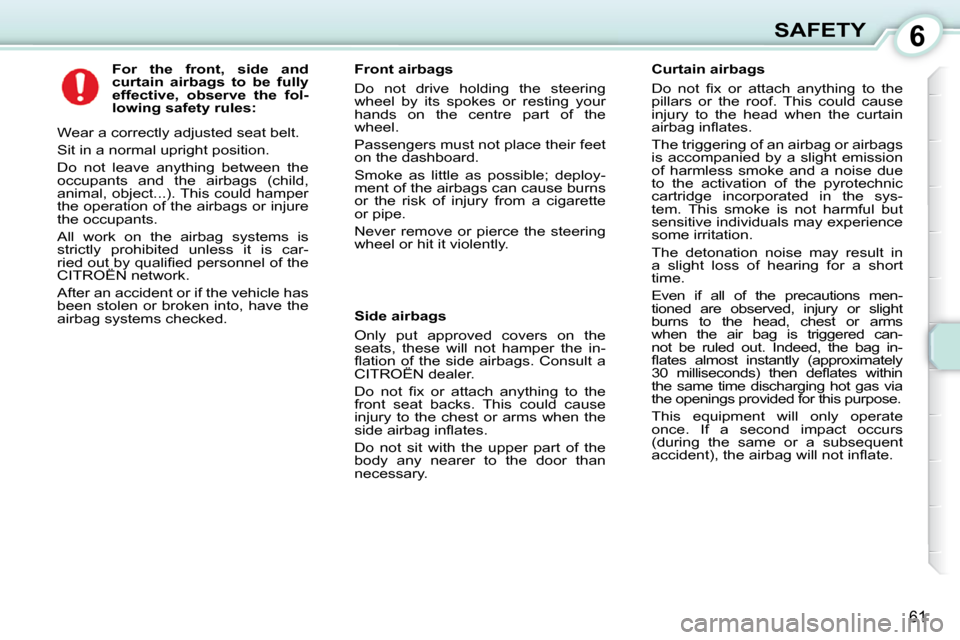
6
61
SAFETY
For the front, side and
curtain
airbags
to be fully
effective, observe the fol-
lowing safety rules:
Wear a correctly adjusted seat belt.
Sit in a normal upright position.
Do not leave anything between the
occupants and the airbags (child,
animal, object...). This could hamper
the operation of the airbags or injure
the occupants.
All work on the airbag systems is
strictly prohibited unless it is car-
�r�i�e�d� �o�u�t� �b�y� �q�u�a�l�i�fi� �e�d� �p�e�r�s�o�n�n�e�l� �o�f� �t�h�e�
CITROËN network.
After an accident or if the vehicle has
been stolen or broken into, have the
airbag systems checked. Front airbags
Do not drive holding the steering
wheel by its spokes or resting your
hands on the centre part of the
wheel.
Passengers must not place their feet
on the dashboard.
Smoke as little as possible; deploy-
ment of the airbags can cause burns
or the risk of injury from a cigarette
or pipe.
Never remove or pierce the steering
wheel or hit it violently.
Curtain airbags
� �D�o� �n�o�t� �fi� �x� �o�r� �a�t�t�a�c�h� �a�n�y�t�h�i�n�g� �t�o� �t�h�e�
pillars or the roof. This could cause
injury to the head when the curtain
�a�i�r�b�a�g� �i�n�fl� �a�t�e�s�.�
The triggering of an airbag or airbags
is accompanied by a slight emission
of harmless smoke and a noise due
to the activation of the pyrotechnic
cartridge incorporated in the sys-
tem. This smoke is not harmful but
sensitive individuals may experience
some irritation.
The detonation noise may result in
a slight loss of hearing for a short
time.
Even if all of the precautions men-
tioned are observed, injury or slight
burns to the head, chest or arms
when the air bag is triggered can-
not be ruled out. Indeed, the bag in-
�fl� �a�t�e�s� �a�l�m�o�s�t� �i�n�s�t�a�n�t�l�y� �(�a�p�p�r�o�x�i�m�a�t�e�l�y�
�3�0� �m�i�l�l�i�s�e�c�o�n�d�s�)� �t�h�e�n� �d�e�fl� �a�t�e�s� �w�i�t�h�i�n�
the same time discharging hot gas via
the openings provided for this purpose.
This equipment will only operate
once. If a second impact occurs
(during the same or a subsequent
�a�c�c�i�d�e�n�t�)�,� �t�h�e� �a�i�r�b�a�g� �w�i�l�l� �n�o�t� �i�n�fl� �a�t�e�.� � �
Side airbags
Only put approved covers on the
seats, these will not hamper the in-
�fl� �a�t�i�o�n� �o�f� �t�h�e� �s�i�d�e� �a�i�r�b�a�g�s�.� �C�o�n�s�u�l�t� �a�
CITROËN dealer.
� �D�o� �n�o�t� �fi� �x� �o�r� �a�t�t�a�c�h� �a�n�y�t�h�i�n�g� �t�o� �t�h�e�
front seat backs. This could cause
injury to the chest or arms when the
�s�i�d�e� �a�i�r�b�a�g� �i�n�fl� �a�t�e�s�.�
Do not sit with the upper part of the
body any nearer to the door than
necessary.
Page 68 of 99
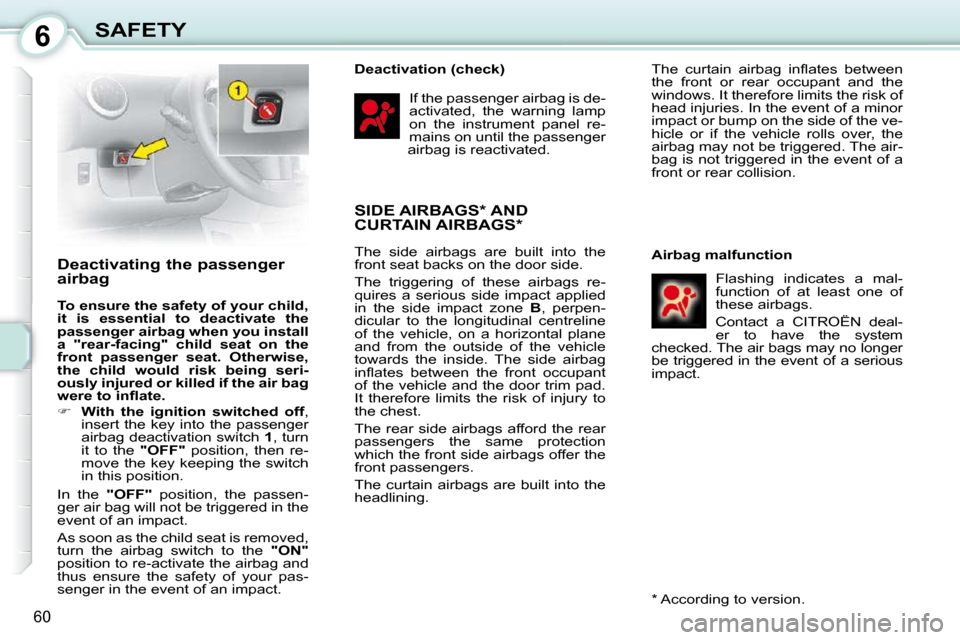
6
60
SAFETY
Deactivating the passenger
airbag
To ensure the safety of your child,
it is essential to
deactivate
the
passenger
airbag
when you install
a "rear-facing" child seat on the
front passenger seat. Otherwise,
the child would risk being seri-
ously injured or killed if the air bag
�w�e�r�e� �t�o� �i�n�fl� �a�t�e�.�
�� With the ignition switched off ,
insert the key into the passenger
airbag deactivation switch 1 , turn
it to the "OFF" position, then re-
move the key keeping the switch
in this position.
In the "OFF" position, the passen-
ger air bag will not be triggered in the
event of an impact.
As soon as the child seat is removed,
turn the airbag switch to the "ON"
position to re-activate the airbag and
thus ensure the safety of your pas-
senger in the event of an impact. If the passenger airbag is de-
activated, the warning lamp
on the instrument panel re-
mains on until the passenger
airbag is reactivated. � �T�h�e� �c�u�r�t�a�i�n� �a�i�r�b�a�g� �i�n�fl� �a�t�e�s� �b�e�t�w�e�e�n�
the front or rear occupant and the
windows. It therefore limits the risk of
head injuries. In the event of a minor
impact or bump on the side of the ve-
hicle or if the vehicle rolls over, the
airbag may not be triggered. The air-
bag is not triggered in the event of a
front or rear collision.
Flashing indicates a mal-
function of at least one of
these airbags.
Contact a CITROËN deal-
er to have the system
checked. The air bags may no longer
be triggered in the event of a serious
impact.
Deactivation (check)
Airbag malfunction
* According to version.
SIDE AIRBAGS * AND CURTAIN AIRBAGS *
The side airbags are built into the
front seat backs on the door side.
The triggering of these airbags re-
quires a serious side impact applied
in the side impact zone B , perpen-
dicular to the longitudinal centreline
of the vehicle, on a horizontal plane
and from the outside of the vehicle
towards the inside. The side airbag
�i�n�fl� �a�t�e�s� �b�e�t�w�e�e�n� �t�h�e� �f�r�o�n�t� �o�c�c�u�p�a�n�t�
of the vehicle and the door trim pad.
It therefore limits the risk of injury to
the chest.
The rear side airbags afford the rear
passengers the same protection
which the front side airbags offer the
front passengers.
The curtain airbags are built into the
headlining.
Page 69 of 99
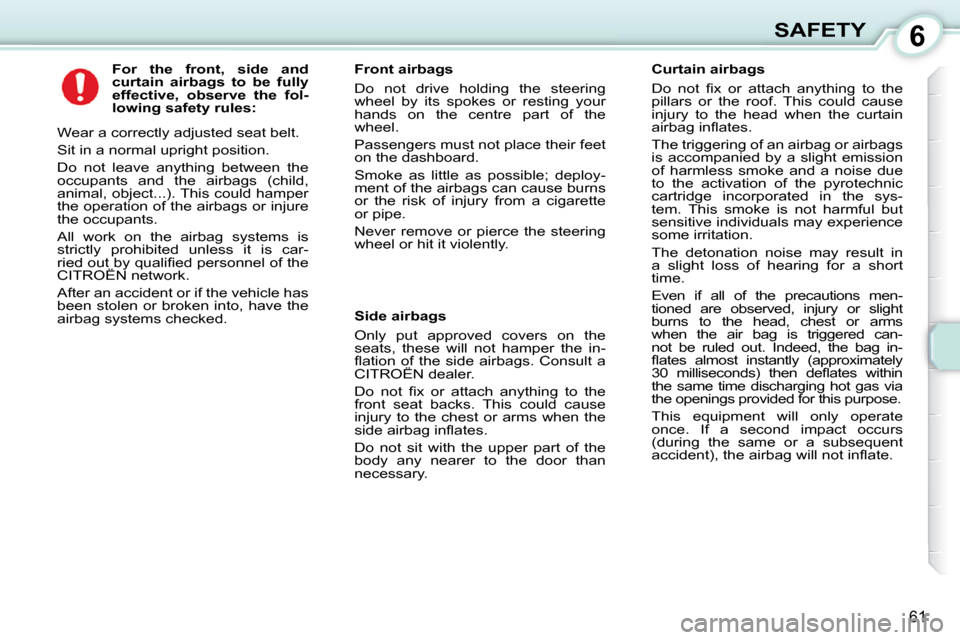
6
61
SAFETY
For the front, side and
curtain
airbags
to be fully
effective, observe the fol-
lowing safety rules:
Wear a correctly adjusted seat belt.
Sit in a normal upright position.
Do not leave anything between the
occupants and the airbags (child,
animal, object...). This could hamper
the operation of the airbags or injure
the occupants.
All work on the airbag systems is
strictly prohibited unless it is car-
�r�i�e�d� �o�u�t� �b�y� �q�u�a�l�i�fi� �e�d� �p�e�r�s�o�n�n�e�l� �o�f� �t�h�e�
CITROËN network.
After an accident or if the vehicle has
been stolen or broken into, have the
airbag systems checked. Front airbags
Do not drive holding the steering
wheel by its spokes or resting your
hands on the centre part of the
wheel.
Passengers must not place their feet
on the dashboard.
Smoke as little as possible; deploy-
ment of the airbags can cause burns
or the risk of injury from a cigarette
or pipe.
Never remove or pierce the steering
wheel or hit it violently.
Curtain airbags
� �D�o� �n�o�t� �fi� �x� �o�r� �a�t�t�a�c�h� �a�n�y�t�h�i�n�g� �t�o� �t�h�e�
pillars or the roof. This could cause
injury to the head when the curtain
�a�i�r�b�a�g� �i�n�fl� �a�t�e�s�.�
The triggering of an airbag or airbags
is accompanied by a slight emission
of harmless smoke and a noise due
to the activation of the pyrotechnic
cartridge incorporated in the sys-
tem. This smoke is not harmful but
sensitive individuals may experience
some irritation.
The detonation noise may result in
a slight loss of hearing for a short
time.
Even if all of the precautions men-
tioned are observed, injury or slight
burns to the head, chest or arms
when the air bag is triggered can-
not be ruled out. Indeed, the bag in-
�fl� �a�t�e�s� �a�l�m�o�s�t� �i�n�s�t�a�n�t�l�y� �(�a�p�p�r�o�x�i�m�a�t�e�l�y�
�3�0� �m�i�l�l�i�s�e�c�o�n�d�s�)� �t�h�e�n� �d�e�fl� �a�t�e�s� �w�i�t�h�i�n�
the same time discharging hot gas via
the openings provided for this purpose.
This equipment will only operate
once. If a second impact occurs
(during the same or a subsequent
�a�c�c�i�d�e�n�t�)�,� �t�h�e� �a�i�r�b�a�g� �w�i�l�l� �n�o�t� �i�n�fl� �a�t�e�.� � �
Side airbags
Only put approved covers on the
seats, these will not hamper the in-
�fl� �a�t�i�o�n� �o�f� �t�h�e� �s�i�d�e� �a�i�r�b�a�g�s�.� �C�o�n�s�u�l�t� �a�
CITROËN dealer.
� �D�o� �n�o�t� �fi� �x� �o�r� �a�t�t�a�c�h� �a�n�y�t�h�i�n�g� �t�o� �t�h�e�
front seat backs. This could cause
injury to the chest or arms when the
�s�i�d�e� �a�i�r�b�a�g� �i�n�fl� �a�t�e�s�.�
Do not sit with the upper part of the
body any nearer to the door than
necessary.
Page 70 of 99

7
62
DRIVING Driver information
The symbol which corresponds to
the selection, R , N , E or M and the
number of the gear engaged 1 to 5 ,
are displayed on the instrument panel
screen.
SENSODRIVE GEARBOX
� �T�h�e� �fi� �v�e�-�s�p�e�e�d� � " SensoDrive "
gearbox offers a choice between the
comfort of automatic operation or the
pleasure of manual gear changing .
Driving mode
� �S�e�l�e�c�t� �t�h�e� �d�r�i�v�i�n�g� �m�o�d�e� �b�y� �m�o�v�i�n�g�
�t�h�e� �g�e�a�r� �l�e�v�e�r�.�
R �e�v�e�r�s�e� �"�R�"�.� �T�h�i�s� �g�e�a�r� �w�i�l�l� �b�e� �e�n�-
gaged when stationary or at a speed
below approximately 4 mph (6 km/h).
� �T�h�e� �e�n�g�a�g�e�m�e�n�t� �o�f� �r�e�v�e�r�s�e� �g�e�a�r� �i�s�
accompanied by an audible signal.
N �e�u�t�r�a�l� �"�N�"�.�
� �P�o�s�i�t�i�o�n� �t�h�e� �l�e�v�e�r� �t�o� �t�h�e� �r�i�g�h�t� �i�n� � N , to
start the engine .
E �a�s�y� �"�E�"�:� �a�u�t�o�m�a�t�i�c� �g�e�a�r� �c�h�a�n�g�i�n�g�.�
M anual ( +/- �)� �"�M�"�:� �m�a�n�u�a�l� �g�e�a�r� �c�h�a�n�g�i�n�g�.� �
Starting the engine
With the parking brake applied, press
the brake pedal then select position N
to start the engine.
With your foot on the brake, select
position R , E or M .
� �R�e�l�e�a�s�e� �t�h�e� �p�a�r�k�i�n�g� �b�r�a�k�e�,� �t�a�k�e� �y�o�u�r�
foot off the brake pedal, then accelerate.
Notes: � �w�i�t�h� �t�h�e� �e�n�g�i�n�e� �r�u�n�-
�n�i�n�g�,� �i�n� �t�h�e�s�e� �t�h�r�e�e� �p�o�s�i�-
tions, an audible signal is
�h�e�a�r�d� �w�h�e�n� �t�h�e� �d�r�i�v�e�r�'�s� �d�o�o�r�
is opened.
You can change from position E to
position M � �a�n�d� �v�i�c�e� �v�e�r�s�a� �a�t� �a�n�y�
time.